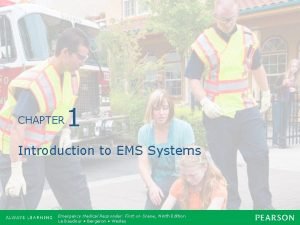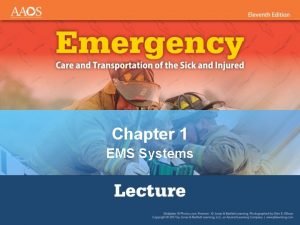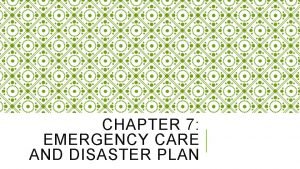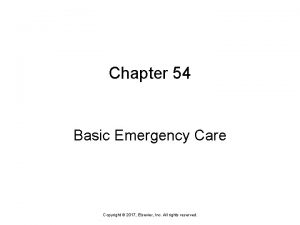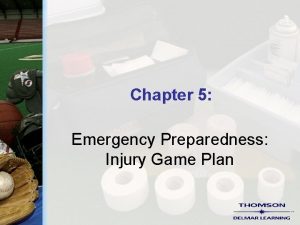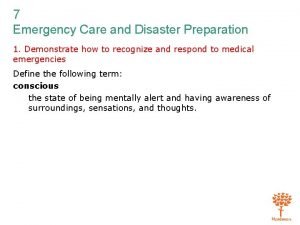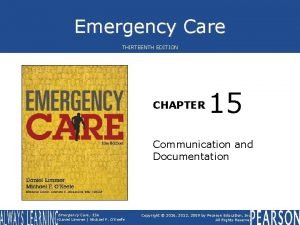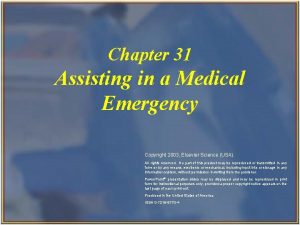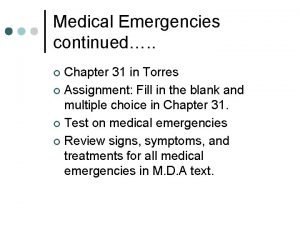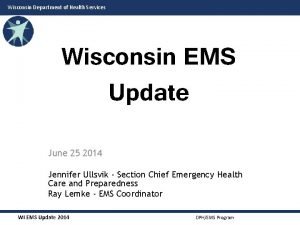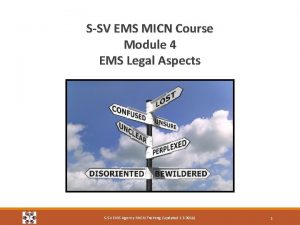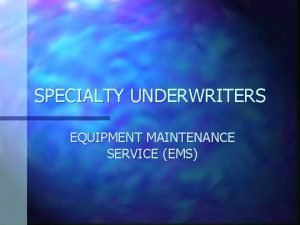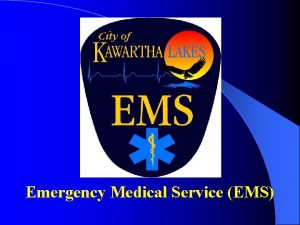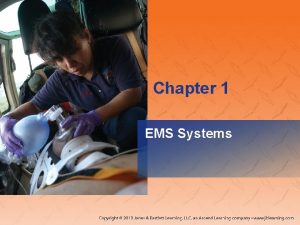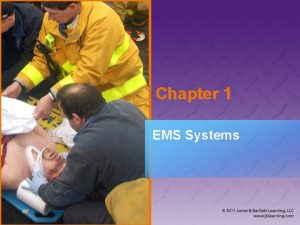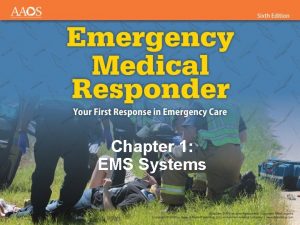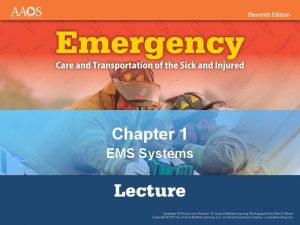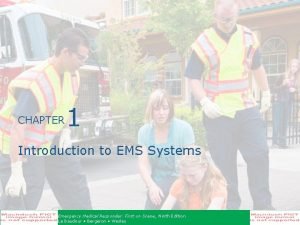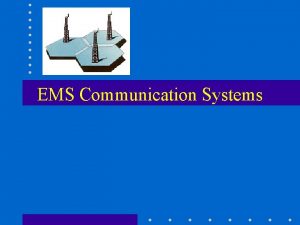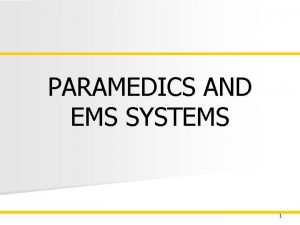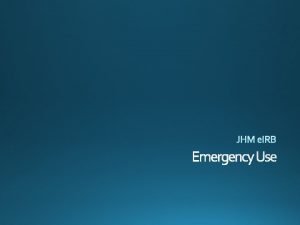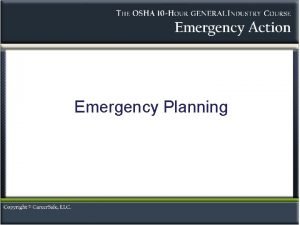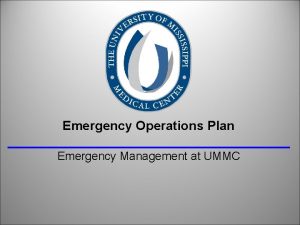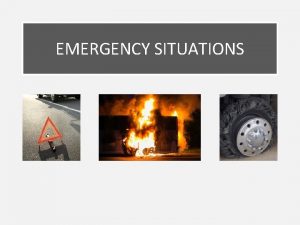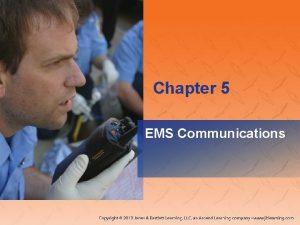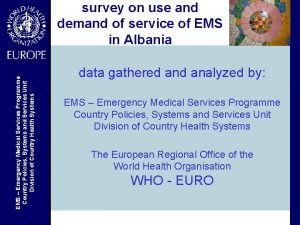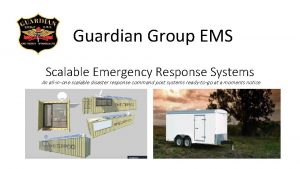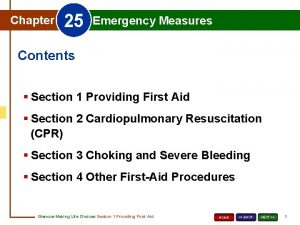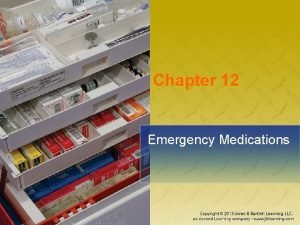Chapter 1 EMS SYSTEMS 1 EMS l Emergency

























- Slides: 25

Chapter 1 EMS SYSTEMS 1

EMS l Emergency Medical Services (EMS) encompasses prehospital emergency care and transportation of the sick and injured l Extends from notification of an incident until delivery to a medical facility l Encompasses treatment and transportation 2

History of EMS (1 of 3) l Emergency care developed during warfare at the beginning of the 20 th century. l By the 1960 s, domestic emergency care lagged behind. l Staffed emergency departments were often limited to large urban areas. 3

History of EMS (2 of 3) l EMS, as we know it today really began with the publication of Accidental Death and Disability: The Neglected Disease of Modern Society (1966) -Recommended: -Development of training -Development of federal guidelines and policies -Provide emergency care and transport -Establish staffed emergency departments 4

History of EMS (2 of 3) l The US DOT developed the first EMS training curriculum in the early 70’s l The TV show Emergency, in the 1970’s, propelled EMS into the mainstream of the US – Johnny Gauge and Roy De. Soto 5

Levels of Training (1 of 2) l Lay Rescuer- “good Samaritan” l First Responder-trained to save a life using a minimum of equipment – In Texas, this level is known as Emergency Care Attendant (ECA) l EMT-B: Uses Basic Life Support, some drugs, and even some invasive procedures 6

Levels of Training (2 of 2) l EMT-Intermediate: Uses some ALS including IVs and advanced airways. Limited Drugs l EMT-Paramedic: Extensive training in EKG interpretation and drug therapies 7

Components of the EMS System (1 of 5) l Access – Easy access in an emergency is essential. – 911 system is now used nation wide l Administration and Policy – Policies and procedures are essential. 8

Components of the EMS System (2 of 5) l Medical Direction and Control -Each EMS system must have a medical director. -Medical control may take place online or offline. Online is via voice. Offline is via protocols (standing orders) -Medical Director serves as a liaison between the medical community, hospitals and an EMT l Quality Control and Improvement -Process used to assure patient care meets standards. 9

Components of the EMS System l Other (3 of 5) physician input – Local, state and national specialists provide guidance. l State-specific statutes and regulations – All EMS systems are subject to state regulations. – In Texas, EMS is regulated by the Texas Department of State Health Services (TDSHS) l Equipment – Properly maintained equipment is essential. 10

Components of the EMS System (4 of 5) l Ambulance – EMT-Bs must be familiar with the ambulance and its functions. l Specialty Centers – Focusing on care for certain types of patients l Interfacility Transports – Transportation of patients from one care facility to another 11

Components of the EMS System l Hospital (5 of 5) Staff – EMS is part of the whole continuum of care. l Working with Public Safety Agencies – EMT-Bs should understand the role of each agency. l Training – Quality of care depends on training. 12

Source: www. ems. gov

Providing a Coordinated Continuum of Care l 1 st Phase—access to EMS system l 2 nd Phase—out of hospital care l 3 rd Phase—emergency department care l 4 th Phase—definitive care

Roles and Responsibilities of the EMT (1 of 5) l Keep vehicles and equipment ready for an emergency. l Ensure safety of yourself, partner, patient, and bystanders. l Operate an emergency vehicle. l Be an on-scene leader.

Roles and Responsibilities of the EMT (2 of 5) l Perform an evaluation of the scene. l Call for additional resources as needed. l Gain patient access. l Perform a patient assessment.

Roles and Responsibilities of the EMT (3 of 5) l Give emergency medical care to patient while awaiting arrival of additional medical resources. l Only move patients when absolutely necessary to preserve life. l Give emotional support to patient, family, other responders.

Roles and Responsibilities of the EMT (4 of 5) l Maintain continuity of care by working with other medical professionals. l Resolve emergency incidents. l Uphold medical and legal standards. l Ensure and protect patient privacy.

Roles and Responsibilities of the EMT (5 of 5) l Give administrative support. l Constantly continue professional development. l Cultivate and sustain community relations. l Give back to the profession.

Professional Attributes (1 of 4) l Integrity l Empathy l Self-motivation l Appearance hygiene and

Professional Attributes (2 of 4) l Self-confidence l Time management l Communication skills l Teamwork and diplomacy l Respect

Professional Attributes (3 of 4) l Patient advocacy l Careful delivery of care l Every patient is entitled to compassion, respect, and the best care.

Professional Attributes (4 of 4) l As health care professionals, EMTs are bound by patient confidentiality. l Be familiar with requirements of the Health Insurance Portability and Accountability Act (HIPAA).

Continuing Education l Continuing (1 of 2) education is required to renew certification l Keep up-to-date on new procedures and issues on local, state, and national levels l Maintain knowledge and skills 24

Continuing Education (2 of 2) l Obtaining the required CE is the responsibility of each EMT l CE requirements set forth by the Texas Department of State Health Services (TDSHS) – Requires 72 hours every 4 years for EMT – Sets minimum hours in certain content areas 25
 Introduction to ems systems chapter 1
Introduction to ems systems chapter 1 Ems systems chapter 1
Ems systems chapter 1 Thompson emergency
Thompson emergency Emergency care and disaster preparation chapter 7
Emergency care and disaster preparation chapter 7 Chapter 54 basic emergency care
Chapter 54 basic emergency care Chapter 5 emergency preparedness injury game plan
Chapter 5 emergency preparedness injury game plan Chapter 36 emergency preparedness and protective practices
Chapter 36 emergency preparedness and protective practices Emergency care first aid and disasters
Emergency care first aid and disasters Chapter 7 emergency care and disaster preparation
Chapter 7 emergency care and disaster preparation Prehospital emergency care 11th edition
Prehospital emergency care 11th edition Emergency care 13th edition
Emergency care 13th edition Chapter 31 assisting in a medical emergency
Chapter 31 assisting in a medical emergency Chapter 36 emergency preparedness and protective practices
Chapter 36 emergency preparedness and protective practices Define medical emergency chapter 31
Define medical emergency chapter 31 Decision support systems and intelligent systems
Decision support systems and intelligent systems Dicapine
Dicapine Embedded systems vs cyber physical systems
Embedded systems vs cyber physical systems Engineering elegant systems: theory of systems engineering
Engineering elegant systems: theory of systems engineering Wisconsin ems license
Wisconsin ems license Deferred payment plan uc merced
Deferred payment plan uc merced Ems felvételre kijelölt posták
Ems felvételre kijelölt posták Verdant thermostat occupancy sensor
Verdant thermostat occupancy sensor Ssv ems
Ssv ems Ems equipment repair
Ems equipment repair Southwest virginia ems council
Southwest virginia ems council Ems latlit
Ems latlit
